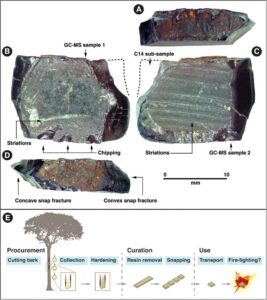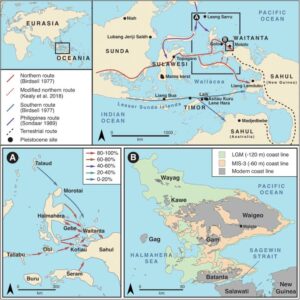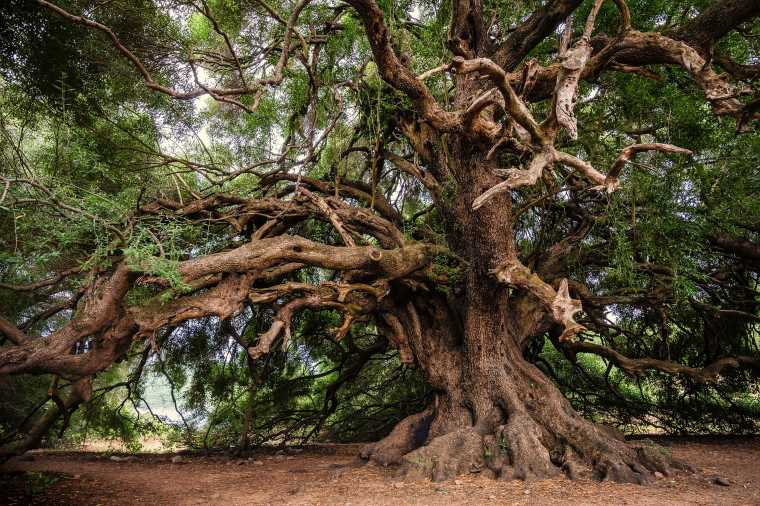An international team of researchers led by archaeologist Dr. Dylan Gaffney says a sample of 50,000-year-old tree resin collected by ancient humans using “sophisticated technological processes” show Homo sapiens likely dispersed into the Pacific as early as 55,000 years ago.
Previous research efforts have argued for an ancient human presence at Madjedbebe rock shelter in northern Australia thousands of years earlier, but those results remain controversial.
The sample of ancient tree resin collected from Mololo Cave on Waigeo Island likely represents the most conclusive evidence that these ancient humans expanded across the islands of the Pacific thousands of years earlier than previously confirmed while also employing sophisticated technological methods along the way. According to the researchers behind the latest study, these results will likely push back the accepted date that humans colonized the numerous islands in the Pacific Ocean by thousands of years.
“The resin from Molokai demonstrates sophisticated technological processes innovated by people moving into rainforest environments,” Gaffney explained. “This adds to our growing understanding of the adaptability and flexibility of early human forager groups in the Pleistocene.”
50,000-Year-Old Tree Resin Collection Reveals Sophisticated Technological Processes
In their study, published in the scientific journal Antiquity, the research team notes that the exact date humans expanded across the Pacific remains hotly debated. As previously noted, some evidence of human occupation in ancient northern Australia dates back as far as 65,000 years ago. Unfortunately, those dates seem to conflict with the overwhelming lack of evidence found along the northern route ancient humans would have likely traveled to reach the region. As a result, the oldest agreed-upon arrival of ancient humans in the Pacific dates to about 44 thousand years ago.
In their study, Dr. Gaffney and colleagues say that new evidence of manually collected and processed 50,000-year-old tree resin shows that humans using sophisticated technological processes arrived on Waigeo Island, which lies along the northern route most suited for human expansion into Australia, as much as 50 to 55 thousand years ago. The new finding exceeds past estimates by close to 10,000 years, revealing that humans likely traversed the Pacific millennia earlier than once thought.
“The tree resin artefact provides evidence for complex plant processing during early human dispersal,” they write. The researchers note that the resin sample is “rectilinear,” which is “totally unlike globular, naturally formed resins.” They argue that this finding indicates it was “collected by humans directly from the tree.”
An analysis of the 50,000-year-old tree resin using a scanning electron microscope also showed that it was produced “in a multi-step sequence.” This idea was supported by various “chipping and scraping” marks on the different surfaces of the resin. Furthermore, the researchers say the shape and structure of the ancient resin sample revealed that it was likely made by humans who “cut into the trunk of the tree itself.”


Evidence Supports the Idea of Ancient Human Colonization of the Pacific
Although evidence of humans using sophisticated technological processes has been found at various sites worldwide, the researchers behind this latest finding say it is critical in the search for the earliest human migrations across the Pacific Ocean. They also note that their simulations of human movements in the area support this idea, especially the idea of early human sailors reaching the ancient continent of Sahul, which connected Australia and New Guinea.
“We used computer simulations of Pleistocene sea currents to model how long it would have taken to get between these islands,” Gaffney said. “We found that there would have been a high success rate for seafarers wanting to cross these water gaps, and skilled seafarers would have done this relatively easily.”


Surprisingly, those simulations showed that some crossings could have been as short as a few kilometers. The researchers suggest this finding means that ancient seafarers could have manually paddled from island to island.
“Our novel seafaring simulations show that eastward-moving crossings were most easily achieved between Obi–Kofiau–Waitanta, even with minimal propulsion,” they write. “Successful arrivals on Waitanta by paddling at 1.5kt (0.77m/s) were nearly guaranteed when moving from Kofiau, Gebe, and Halmahera in the west or Sahul in the east. Even in suboptimal weather, movements between Waitanta and Sahul across the Sagewin Strait were safe for rafts paddled at 1.5kt but were also possible with slower paddling during ideal conditions.”
Other Ancient Human Populations Not Ruled Out
In the study’s conclusion, the researchers acknowledge that the exact use of the extracted 50,000-year-old tree resin is unknown. However, they point out that the process they described in their research is consistent with “ethnographic accounts” of how Waigeo people living in the area extracted tree resins in more recent centuries. The team also suggests that it could have been used for fuel fires, boat construction, or to attach stone tools to wooden handles. Regardless of the resin’s intended use, the team says the finding of 50,000-year-old technology on this remote Pacific island offers significant support for the migration of ancient humans thousands of years before previously confirmed.
“The Mololo investigations provide critical, albeit sparse, evidence for occupation along the northern equatorial route to Sahul before 50ka (possibly >55ka),” they write. “H. sapiens probably produced this archaeological record, moving by raft/boat through the humid tropics.”
The team concedes that further research is needed to confirm their findings, noting the possibility that another ancient human ancestor extracting the resin cannot be ruled out.
“It should be noted that based on modern population genetic evidence, it is not currently possible to exclude the possibility that Denisovans or people who carried both H. sapiens and Denisovan ancestry—having admixed in the islands of Wallacea or continental Eurasia—migrated along this route,” they conclude.
Christopher Plain is a Science Fiction and Fantasy novelist and Head Science Writer at The Debrief. Follow and connect with him on X, learn about his books at plainfiction.com, or email him directly at christopher@thedebrief.org.

